1. Introduction
 Point
of View is a relatively new graphics card retailer and an official NVidia
Partner. All Point Of View graphics cards are covered by a 3-year warranty
and as part of their new campaign, all cards will be accompanied by the hottest
games.
Point
of View is a relatively new graphics card retailer and an official NVidia
Partner. All Point Of View graphics cards are covered by a 3-year warranty
and as part of their new campaign, all cards will be accompanied by the hottest
games.
In this review we'll take a look at an NVidia 6200 TurboCache
from POV. The 6200 TC is an entry level card for the low-budget market, below
$100.
- Packaging/Bundle
The 6200TC ships in a relatively small package, which features
the iguanna theme from Point Of View on the front. Large stickers also on
the front, indicate the
card's main characteristics, such as TurboCache technology with
support for up to 256MB RAM, the 128-bit bus and the PCI-Express slot type.
 |
| Point Of View 6200 TurboCache |
Inside the packaging you'll find the following:
- Full DVD version of Thief: Deadly Shadows
- S-Video cable
- 6200TC Product Manual
- POV Driver CD
Yes, strangely enough as part of their King of the Bundle campaign,
POV decided to include Thief 3: Deadly Shadows with the 6200TC. That was
quite surprising for us, as that particular game is known to be very
GPU intensive and even high end cards have trouble delivering enough framerates.
We'll see how the POV 6200TC performed with that game later on.
2. Features-TurboCache
| Main Features |
| GPU |
Nvidia 6200 - NV44 |
| Memory Brand/Model |
Samsung K4D261638F-TC36 (3.6ns) |
| Memory Type |
64 MB(potential 256MB) 128-bit DDR |
| Engine Clock Speed |
350MHz |
| Memory Clock Speed |
275MHz |
| Memory Bandwidth |
12.4 GB/sec |
| Pixel Pipelines |
4 |
| Vertex Pipelines |
3 |
| Fill rate |
1.4 Giga pixels/sec |
| DX Support |
9.0 |
| OpenGL Support |
1.5 |
| Output |
VGA / DVI-I / D-Sub |
| Bus |
PCI-Express x16 |
| Processing technology |
0.11 micron |
The 6200TC is aimed directly at the entry level market so there's not much
to expect in terms of features. The card is based on the latest Nvidia core,
the
NV44 chipset. The NV44 features 4 Pixel pipelines and 3 Vertex engines with
a memory bus 128-bits wide.
 |
| The 3.6ns memory parts by Samsung |
The POV 6200 TC utilizes a set of Samsung K4D261638F-TC36 memory modules
able to run at 3.6ns, which give the card a total of 64MB physical memory.
Even
if 64MB might seem insufficient, especially for a brand new graphics card,
this is not the case here. Since these 64MB will be mainly used as a buffer
for
the real memory, this amount will be more than enough. Let's see what this
TurboCache technology is and why it's being promoted these days.
TurboCache
The problem in creating an entry-level graphics card is basically keeping
the production costs as low as possible. Of course, all the capacitor and
resistor costs are next to nothing and even the GPU's cost is under the control
of the manufacturers. The problem in maintaining a low production
cost is focused
on the memory modules. No matter how cheap everything else gets, the memory
required by a graphics card is always expensive. To solve that problem,
both Nvidia and
ATi have come up with their own separate but similar solutions.
The PCI-Express architecture offers double the bandwidth that AGP could and
most importantly, that high transfer speed is available bidirectionally between
the system bus and the graphics card. So why let all this new available bandwidth
go to waste?
TurboCache is the name of Nvidia's solution. It utilizes the bandwidth of the bus to simulate extra graphics card memory using your computer's physical memory. As a result a TC graphics card can even operate with only 16Mb of local memory which needs to be used as a buffer. The TC architecture at this case would provide the card with an extra 128MB RAM of virtual memory.
All the latest Nvidia drivers now have a hidden feature for TC cards, the TurboCache Manager (TCM). Whenever your graphics card demands more memory for storage, TCM allocates the needed memory and also keeps track of where all that data is located. As soon as your game or application exits, TCM once again releases the memory to become available for system use.
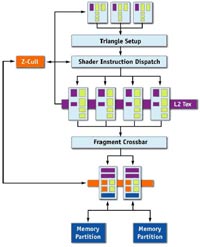 |
 |
| 6200 |
6200TC |
TurboCache is achieved through some hardware changes in the core. The yellow
rectangles on the right on the picture above, indicate the changes made on
the NV44. What's most important is the addition of an MMU (Memory Management
Unit)
circuit.
All memory requests are now passed through the MMU which decides if the address
exists on local memory or the physical memory of the computer. It then performs
the read or write depending on the kind of request.
One last thing to note here about the POV 6200 TC is that in order to allocate the 256MB it supports, it needs at least 512MB of physical memory.
CineFX 3.0 Engine
Powers the next generation of cinematic realism. Full support for Microsoft® DirectX® 9.0 Shader Model 3.0 enables stunning and complex special effects. Next-generation shader architecture delivers faster and smoother gameplay.
NVIDIA PureVideo Technology
The combination of the GeForce 6 Series GPU's high-definition video processor
and NVIDIA video decode software delivers unprecedented HD video, stunning
picture clarity, smooth video, accurate color, and precise image scaling for
all video content to turn your PC into a high-end home theater. This feature
requires
supported video software. Features may vary by product.
nView Multi-Display Technology
The nView hardware and software technology combination delivers maximum flexibility for multi-display options, and provides unprecedented end-user control of the desktop experience. NVIDIA GPUs are enabled to support multi-displays, but graphics cards vary. Please verify multi-display support in the graphics card before purchasing.
Digital Vibrance Control 3.0 Technology
Allows the user to adjust color controls digitally to compensate for the lighting conditions of their workspace, in order to achieve accurate, bright colors in all conditions.
OpenGL® 2.0 Optimizations and Support
Ensures the best performance and application compatibility for all OpenGL applications.
Microsoft® DirectX® 9.0 Shader Model 3.0 Support
Ensures top-notch compatibility and performance for all DirectX 9 applications, including Shader Model 3.0 titles.
High-Definition MPEG-2 Hardware Acceleration
Smoothly playback all MPEG-2 video with minimal CPU usage so the PC is free to do other work. Battery-life is extended when watching DVDs while running on battery. MPEG-2 is the standard format for DVDs, is accepted as a format for HD-DVD, and is also used for HD broadcast.
3. A closer look
The POV 6200TC is a very simple-looking card. It's built on a blue PCB and follows NVidia's 6200TC reference design.
 |
| The front side of the card.(click for hi-res). |
A black aluminum heatsink covers the NV44 GPU to make
sure it doesn't overheat. This passive cooling solution along
with the card's
low
price, make it ideal for video playback on a Multimedia Home PC.
 |
| The front side of the card.(click for hi-res). |
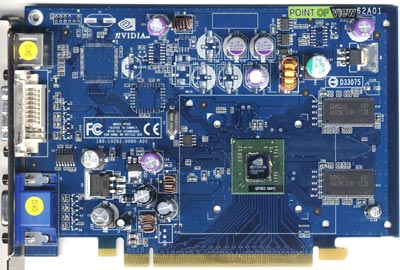 |
| The front side of the card without the heatsink.(click for hi-res). |
Removing the heatsink reveals the NV44 core of the 6200TC.
We were surprised when we saw how small it was compared to the mid and high-end
GPUs we were accustomed to.
 |
| Enlarged picture of the NV44 |
 |
| S-Video, DVI and the standard VGA output for the POV 6200TC. |
4. Test System
Processor: Intel P4 3.0GHz L775
Cooler: Big Typhoon
Case: Antec 1080AMG
Motherboard: Gigabyte 8I915P Duo Pro
Memory: 2x512MB OCZ PC-4200 Memory
Hard Disk Drive: WD800JD 80GB 7200RPM
DVD-RW: LiteOn LTR-52246S
PowerSupply: Levicom 500Watt
Microsoft WindowsXP Pro SP2
DirectX v9.0c

Benchmarking Software
3DMark05,03,01
Codecreatures Benchmark Pro
AquaMark3 v3.0
ATiTool 0.0.23
Farcry v1.3
CounterStrike Source
Doom 3
Thief 3
Ground Control II
5. 3DMark05
 With 3DMark05, Futuremark continues the tradition in its benchmarking software by providing a state-of-the-art Microsoft ® DirectX ® 9 3D performance benchmark.
With 3DMark05, Futuremark continues the tradition in its benchmarking software by providing a state-of-the-art Microsoft ® DirectX ® 9 3D performance benchmark.
3DMark05 is an all new 3DMark version taking the most out of Microsoft's DirectX
9. The previous version 3DMark03, did a nice introduction into this level
of technology. However 3DMark03 used DirectX 9 specific features in a limited
manner, because fully supporting  hardware
was rare at the time of its launch. In contrast, 3DMark05 requires DirectX
9 hardware with full support for at least Shader Model 2, and takes shader
usage to never before seen levels.
hardware
was rare at the time of its launch. In contrast, 3DMark05 requires DirectX
9 hardware with full support for at least Shader Model 2, and takes shader
usage to never before seen levels.
Just like its predecessors, 3DMark05's point system is set so that at the
moment of release, the high-end VGA cards available in stores can only score
around 5000 3DMarks, whereas the worst card that meets the programs requirements
yields a score of 1000.
Game Test 1 -Return to Proxycon
Being the sequel to the "Battle of Proxycon"
from 3DMark03, in "Return to Proxycon" we're once again set in space
and the battle continues as space pirates invade a cargo ship in order to
take control of its valuable cargo.
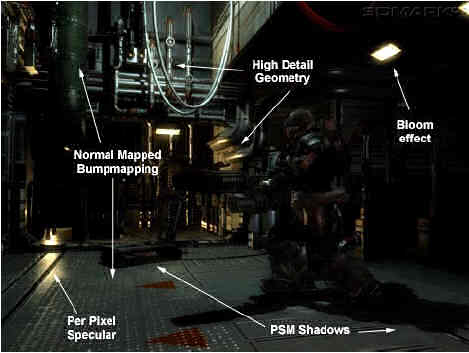
This test, tries to simulate a future first-person shooter game with all the high details that entails. The dynamic shadows, high-detailed environment and advanced lighting techniques ensure that under normal circumstances, no recent card can run it with decent frame rates.

3DMark05 is the latest in benchmarking technology
from Futuremark, and as you can see, the low end cards performance is far
from satisfactory.
Game Test 2 - Firefly Forest
A forest gets filled with magic fireflies in the night. The moon is nearly full, illuminating the forest with a bluish faint light. The magic fireflies have flickering bright green lights that playfully move around the forest.
This scene is a nice example of a smaller scale outdoor scene with rich vegetation. Immediate visibility is not so far, and there is a skybox surrounding the whole scene.

A large number of trees with their branches swinging separately, and dense vegetation being dynamically distributed according to the camera movements, make this test the most demanding of the three.

The GT2 is much worse than the X600XT which was supposed
to be a next-gen card that failed to deliver more than 4fps.
Game Test 3 - Canyon Flight
A Jules Verne type airship flies through a canyon guarded
by a dangerous sea monster. The airmen defend their ship using heavy cannons,
but these seem to have no effect on the huge sea monster.
Finally the crew manages a narrow escape using the "last resort" afterburners
of the airship.
This scene is fairly complex with large areas of
water reflecting the high canyon walls. The water actually is one of the key points of interest in this scene.
The water not only does realistic looking reflections and refractions, it has a depth fog, making the sea
monster swimming under the airship actually look deep down in the water. The air in this scene also uses
a volumetric fog, making distant cliffs of the canyon really look far away.

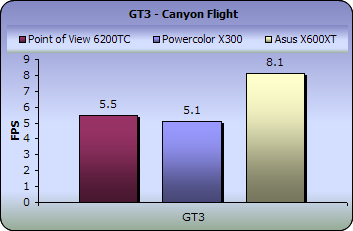
In GT3, the Point of View 6200TC once again seems to be more
powerful than its main rival, the X300. In this case, the difference between
them however is ridiculously small, as it was in the previous two cases,
so
we shouldn't
come to any conclusions yet.
Final Score
3DMarks on 3DMark05 are now calculated by the following formula:
(Game Test 1 * Game Test 2 * Game Test 3)^0.33 * 250
This is basically the geometric mean of the total frames
in each game multiplied by 250. This means that all game tests are now equal.
Let's see our results for the POV 6200TC:

The final score reveals nothing more than each of the separate
tests did. The 6200TC performance is not that much better than
the X300 sample from Powercolor, while the X600XT sits a little bit higher.
6. 3DMark 2003
 3D Mark is a widely used and accepted benchmark that stresses the DirectX performance of a VGA card. A very strong point of 3DMark is that it's VGA card measuring is does not require any CPU power. So the resulting fps are a good reference a VGA card's rendering performance. For testing the performance of each card we used the 4 game benchmarks 3DMark has.
3D Mark is a widely used and accepted benchmark that stresses the DirectX performance of a VGA card. A very strong point of 3DMark is that it's VGA card measuring is does not require any CPU power. So the resulting fps are a good reference a VGA card's rendering performance. For testing the performance of each card we used the 4 game benchmarks 3DMark has.
3Dmark03 also includes sound and CPU tests as well as some other feature tests.
- Game Test 1 - Wings of Fury (DX7)

This test is a combat flight simulator written for older
hardware (DirectX 7). Particles are used a lot in this test - smoke and vapor
trails, flak and gunfire, and explosions are produced using point sprites
and quads.
- Game Test 2 - Battle of Proxycon (DX8)

This test is a simulation of first person shooter game types. 1.1 and 1.4 Vertex shaders are widely used since all character models are skinned using vertex shaders.This makes this test a good vertex shader comparison for VGA cards.
- Game Test 3 - Trolls' Lair (DX8)
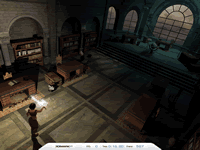
This test should be the favorite of all RPG lovers. It is a cut scene of a female warrior facing two malicious trolls. Again the same vertex and pixel processing is used as in game test 2.
This test also uses post-processing effects, such as Depth of Field and Bloom effects which are widely used in today's game cut scene sequences.
- Game Test 4 - Mother Nature (DX9)

Mother nature represents the level of effects and realism that are possible using 2.0 vertex and pixel shaders, plus some other features that DirectX 9 offers.

In the DirectX 7 based GT1, the X600XT reigns with 50% higher
performance from the second placed X300 while the POV 6200TC ran the benchmark
5fps slower. In GT2 and GT3 which measure DX8 and GT4 which measures
DX9 performance, the 6200TC did a little better than the X300.
- 3DMark Official score
If you test your machine with 3DMark, you can post the results
at 3DMark's online result browser. For more information visit futuremark.com.
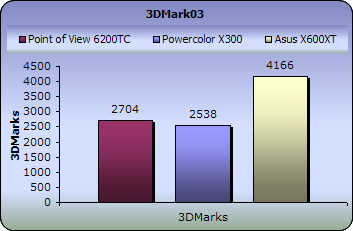
As in 3DMark05, the 6200TC and X300 show very similar performance. The X600XT offers the best performance, with the 6200TC leading the rest of the entry level cards.
7. Codecreatures
 CodeCreatures is a synthetic 3D benchmark that is a good reference for VGA performance comparison. This is a high-end 3D benchmark that also requires DirectX 8 hardware, making a good tool for measuring the potential of DirectX 8 game performance.
CodeCreatures is a synthetic 3D benchmark that is a good reference for VGA performance comparison. This is a high-end 3D benchmark that also requires DirectX 8 hardware, making a good tool for measuring the potential of DirectX 8 game performance.
The Codecreatures benchmark is written with Microsoft's DirectX 8.1 API and incorporates the use of Vertex and PixelShaders popular on next generation 3D accelerators.
 The benchmark plays a photo-realistic nature scene and calculates the performance of the graphics adapter by measuring the fps that it can display at 1024x768, 1280x1024 and 1600x1200 resolutions.
The benchmark plays a photo-realistic nature scene and calculates the performance of the graphics adapter by measuring the fps that it can display at 1024x768, 1280x1024 and 1600x1200 resolutions.

-Codecreatures number
The codecreatures number is the resulting score of the total benchmarking process and is basically the geometric mean of the three framerates multiplied by 100.

As you can see, none of the cards really hold the power to run
Codecreatures under all resolutions sufficiently.
8. Aquamark3 / 3DMark 2001
 Since the majority of today's applications and games are compatible with DirectX 9, the need of benchmark applications that use DX 9 has been brought up. The benchmark uses the 3D engine (Krass engine) of the Aquanox game.
Since the majority of today's applications and games are compatible with DirectX 9, the need of benchmark applications that use DX 9 has been brought up. The benchmark uses the 3D engine (Krass engine) of the Aquanox game.
Aquamark Triscore
The Aquamark Triscore comprises 3 values: the overall system performance, the performance of the graphics system and the CPU performance. Keep in mind that this is not the total result of the tests, but the result of the whole benchmark process including all 9 chapters.

3DMark 2001
3DMark 2001 is the predecessor to 3DMark03. It's mainly a directx8.1 benchmark and the score depends a lot on the CPU power of your computer. However for reference use only we decided it'd be best to just leave it in our benchmark list so you can compare the next generation cards with the possibly outdated you have at home.

9. Half life 2
Half life 2 is no doubt the most anticipated pc game of all times. Gamers keeping the excellence of Half Life 1 in their mind as well as the remarkable E3 demo preview, have been anxiously waiting for the much delayed release of HL2.
 Regarding the storyline, the player again picks up the crowbar of research scientist Gordon Freeman, who finds himself on an alien-infested Earth being picked to the bone, its resources depleted, its populace dwindling. Freeman is thrust into the unenviable role of rescuing the world from the wrong he unleashed back at Black Mesa. And a lot of people he cares about are counting on him.
Regarding the storyline, the player again picks up the crowbar of research scientist Gordon Freeman, who finds himself on an alien-infested Earth being picked to the bone, its resources depleted, its populace dwindling. Freeman is thrust into the unenviable role of rescuing the world from the wrong he unleashed back at Black Mesa. And a lot of people he cares about are counting on him.
Characters - Advanced facial animation system delivers the most sophisticated in-game characters ever seen. With 40 distinct facial "muscles," human characters convey the full array of human emotion, and respond to the player with fluidity and intelligence.
Physics - From pebbles to water to 2-ton trucks respond as expected, as they obey the laws of mass, friction, gravity, and buoyancy.
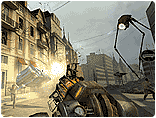
Graphics - Source's shader-based renderer, like the one
used at Pixar to create movies such as Toy Story® and Monster's, Inc.®,
creates the most beautiful and realistic environments ever seen in a video
game.
AI - Neither friends nor enemies charge blindly into the fray. They can assess threats, navigate tricky terrain, and fashion weapons from whatever is at hand.
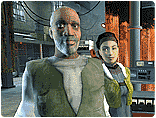 To measure performance we used the Video Stress Test(VST) that is available in the CounterStrike:Source beta available through Steam. We set all the details to the highest level and each time changed the resolution from 800x600 up to 1600x1200.
To measure performance we used the Video Stress Test(VST) that is available in the CounterStrike:Source beta available through Steam. We set all the details to the highest level and each time changed the resolution from 800x600 up to 1600x1200.

In the Half Life 2 Video Stress test, the 6200 TC and the X300 deliver pretty much the same performance. In real gameplay situations however only 800x600 would be playable.

Here's an interesting result. Anti-Aliasing and Anisotropic
Filtering is a disaster for the Nvidia 6200 which dropped its framerate by
about 50% while ATi's low-end card only by 30%.
10. Doom 3

A massive demonic invasion has overwhelmed the Union Aerospace Corporations? (UAC) Mars Research Facility leaving only chaos and horror in its wake. As one of the few survivors, you struggle with shock and fear as you fight your way to Hell and back, in an epic clash against pure evil.
Activision made it's miracle again with Doom 3 which is said to be the best-looking game ever, thanks to the brand-new OpenGL graphics engine used to generate its convincingly lifelike, densely atmospheric, and surprisingly expansive environments. If you are a fan of the previous Doom games then you will get many flashbacks with this revision, since you will find reimagined versions of almost every monster from both Doom and Doom II.

To measure performance on the game we used the timedemo demo1 command from the console (Alt+Ctrl+~).
Enabling the high quality setting and executing the timedemo demo1 command twice for each resolution, we witnessed the following:
First, without the Anti-Aliasing and Anisotropic Filtering settings
enabled, we got the following results:
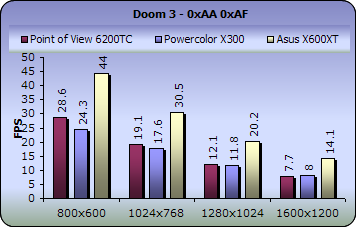
Even if the 6200TC is an NVidia card, that doesn't make it
any easier for it when running the D3 benchmark. In any case, Doom 3 is one
of the most demanding games so far, and low-end cards are far from being
able to supply the
power to render it acceptably.

For reference use, here's how the cards ran the game with
quality settings enabled.
11. Far Cry

 You are Jack Carver running your own boat charter business in beautiful Micronesia. With a past best left behind you, you'll be focusing on your present assignment: escorting an ambitious journalist named Valerie Cortez to the Island of Cabatu. It seems like a piece of cake, but you'll soon learn: paradise can be hell.
You are Jack Carver running your own boat charter business in beautiful Micronesia. With a past best left behind you, you'll be focusing on your present assignment: escorting an ambitious journalist named Valerie Cortez to the Island of Cabatu. It seems like a piece of cake, but you'll soon learn: paradise can be hell.
Farcry is an awesome First Person Shooter (FPS) based on a last generation 3D engine named as CryEngine. Real-time editing, bump-mapping, static lights, network system, integrated physics system, shaders, shadows and a dynamic music system are just some of the state of-the-art features that the CryEngine offers.
A great advantage and strong point of the CryEngine is its physics system which supports character inverse kinematics, vehicles, rigid bodies, liquid, rag doll, cloth and body effects. All physics seem to be very realistic and you never get bored when facing enemies, since character models have multiple animations that blend in believable ways.
With an integrated shader system and a massive terrain which maximizes
the view distance to 2km, these features make Farcry a perfect action game and
also a referable benchmark to speak of.
- Benchmark Settings
For this game we recorded a custom demo from the start of the Rebellion
stage. We chose an indoor scene in order to avoid getting the CPU bound effect. This will result in slightly higher results since it is also less
GPU intensive, but we can't afford being stuck at 40-50 fps because of our CPU.

The latest patch (1.3) was used for our tests which updates the
game's graphics engine to use the 3.0 Shader model. This option is only supported
for the 6800 series.

The resolutions we ran the demo under, are as follows: 800x600,1024x768,
1280x1024 and 1600x1200. The first test was committed with Anti Aliasing (AA)
and Anisotropic Filtering (AF) features off. In the second test we leveled
up AA to 4x and AF to 8x. All tests were taken with Jack's flashlight on,
to increase
the game's demands from the graphics cards and with ai_update_interval set
to zero so that the results are subjective.

As these cards would really have trouble rendering the benchmark
scene, we had the flashlight turned off in order to improve performance and
maybe create an actually playable benchmark. Be it so, the POV 6200TurboCache
outputs a satisfactory amount of frames per second at 800x600. Increasing the
resolution to 1024x768, gameplay becomes a little choppy but is still playable.
Anti-Aliasing and Anisotropic Filtering is of course pointless
for these cards in Far Cry, so we'll just skip that part.
12. Thief 3
 Thief
3 Deadly Shadows is based on the same engine as DeusX. The
game makes severe use of Pixel Shader 1.1 instructions, the bloom effect
and stencil shadows to achieve a wonderful result on your screen.
Thief
3 Deadly Shadows is based on the same engine as DeusX. The
game makes severe use of Pixel Shader 1.1 instructions, the bloom effect
and stencil shadows to achieve a wonderful result on your screen. 
In the game, you play the part of Master Thief Garrett who is back to
rule out any evil forces using his unique stealth abilities. Deadly Shadows
shows what stealth gameplay is all about. This game really gives you the
feeling of sneaking around and holding your breath when stuck in a sticky
situation.
Since there is no official benchmark for the game, we'll do our
tests using a GPU intensive scene from the tutorial-level which we believe
that represents the average fps you'll get when playing the game.
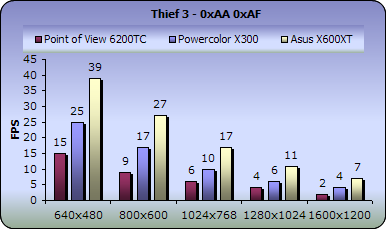
It's time to test the card's bundle with the card itself. Sadly,
the high quality settings we usually use are catastrophic for the card. Even
under the lowest resolution of 640x480, it can't output more than 15fps.
13. Colin McRae 05
 For all you racing fans out there, this test is for you and will represent the Racing game category in our benchmarks.
For all you racing fans out there, this test is for you and will represent the Racing game category in our benchmarks.
From the graphics point of view the first thing you'll
notice in the game is the excellent amount detail of your racing car. High
resolution textures on the car and lighting make it quite impressive. All
the eye candy such as the sun reflection in the virtual camera are still
the same as the older CM versions but motion blur has been added when your
card hits something hard which will happen most often if you're new to
the racing simulation world.
To measure performance on the game we used fraps to get the average fps of the whole 8th stage of UK which is actually the only stage you get to play on the demo.

In Colin McRae 05, the performance of the X300 exceeds the
performance of the 6200TC by a few fps. Using the latter, the
only acceptable resolutions for enjoying the game are at 800x600 and 1024x768.

Enabling the quality settings for AA and AF, only the X600XT
can come up with acceptable performance.

14. Ground Control II
 Ground
Control 2 is an action-oriented game of tactics and warfare. As Captain Jacob
Angelus of the Northern Star Alliance, you will command squads of infantry,
artillery, and airpower against the might of the Empire of Terra. Base building
and
Ground
Control 2 is an action-oriented game of tactics and warfare. As Captain Jacob
Angelus of the Northern Star Alliance, you will command squads of infantry,
artillery, and airpower against the might of the Empire of Terra. Base building
and  resource-collecting
are replaced with unit control and combat tactics where your knowledge of
the battlefield maneuvers will make the difference in your fight against
a ruthless enemy. Position your troops on hilltops for better aim or inside
buildings and forests for protection as you'll need to use every inch of
terrain to your advantage. Call in air strikes or assault pods to bring the
battle
behind enemy lines. Send out scouts to locate the enemy and use spotters
for your artillery with the 360° free-roaming camera. Experience the total
immersion of futuristic warfare as you lead your forces to victory!
resource-collecting
are replaced with unit control and combat tactics where your knowledge of
the battlefield maneuvers will make the difference in your fight against
a ruthless enemy. Position your troops on hilltops for better aim or inside
buildings and forests for protection as you'll need to use every inch of
terrain to your advantage. Call in air strikes or assault pods to bring the
battle
behind enemy lines. Send out scouts to locate the enemy and use spotters
for your artillery with the 360° free-roaming camera. Experience the total
immersion of futuristic warfare as you lead your forces to victory!
For our benchmarks, we used the highest possible settings on the first mission
of the single player game and moved around the camera to get an average framerate
using fraps.

Ground Control II offers really impressive graphics without requiring much GPU power. Click on the picture above to view a screenshot from the game. Check out these excellent water effects!

Fortunately, all cards were able to provide enough fps for Ground
Control, up to 1024x768.

Of course, AA and AF would do nothing but ruin the previous performance
and under no circumstances should they be used for playing the game.

15. Overclocking
No matter your graphics card, there comes a time in your computer's life when it can no longer cope with the latest technology the ever so popular games use. This is one of the main reasons for overclocking your graphics card. Gamers are always looking forward for a little extra boost in terms of framerate. Even though most of the times the boost is far from noticeable, overclocking remains the last resort when you can't afford to buy a brand new VGA card.
 |
Increasing the memory clock too much,
produces the so-called "artifacts". |
The stock clock speeds for the Point Of View 6200 TurboCache are 350MHz for
the GPU and 275MHz for the memory. Using coolbits, we unlocked the hidden overclocking
utility of the NVidia drivers and used it to change these frequencies to 400MHz
and 325MHz.



The performance boost we got is moderately good. Fortunately,
the framerates increased right where we needed them to increase: in the lowest
resolutions, providing us with a more enjoyable game environment.
16. Conclusion
Good performance is not something you would ever expect from a budget level
card and the 6200TC is no exception to the rule. However, there are major improvements
from the previous class representatives, the 9200 and FX5200 that almost double
the performance but still, if you would describe yourself as a gamer, then
maybe you're looking at the wrong solution to your needs.

The price of the Point Of View 6200 TurboCache is approximately €70.
Even though the card's performance is not so great, TurboCache makes the card
much cheaper which actually results in the 6200 being worth its money. The
card offers higher performance than previous generation entry level cards while
maintaining approximately the same cost.
Overclocking the card helped get a little higher performance in our games
but not much more than all cards could do. The 6200 TC is an average overclocker
but every framerate increment is welcome, especially when the graphics card
is already at its limits.
Bundled along with the card, you'll find a full DVD version of Thief 3 :
Deadly Shadows. Thief 3 is a top-quality game but unfortunately the bundle
doesn't really correspond to the card's rendering power and the game is unplayable
unless you use the lowest possible video settings through the Thief 3 Options
menu.

Pros:
-Suitable for home multimedia computers
-Great game included in the package
-Very low price
Cons:
-Poor performance in most games
Performance: |
|
Value for money: |
|
Overclocking: |
|
Bundle: |
|